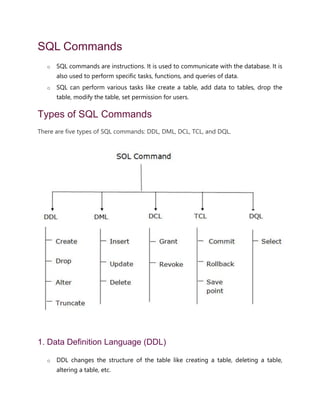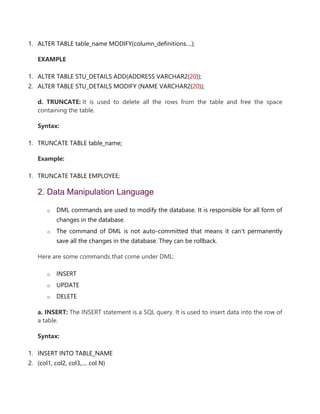ii bcom dbms SQL Commands.docx
- 1. SQL Commands o SQL commands are instructions. It is used to communicate with the database. It is also used to perform specific tasks, functions, and queries of data. o SQL can perform various tasks like create a table, add data to tables, drop the table, modify the table, set permission for users. Types of SQL Commands There are five types of SQL commands: DDL, DML, DCL, TCL, and DQL. 1. Data Definition Language (DDL) o DDL changes the structure of the table like creating a table, deleting a table, altering a table, etc.
- 2. o All the command of DDL are auto-committed that means it permanently save all the changes in the database. Here are some commands that come under DDL: o CREATE o ALTER o DROP o TRUNCATE a. CREATE It is used to create a new table in the database. Syntax: 1. CREATE TABLE TABLE_NAME (COLUMN_NAME DATATYPES[,....]); Example: 1. CREATE TABLE EMPLOYEE(Name VARCHAR2(20), Email VARCHAR2(100), DOB DATE); b. DROP: It is used to delete both the structure and record stored in the table. Syntax 1. DROP TABLE table_name; Example 1. DROP TABLE EMPLOYEE; c. ALTER: It is used to alter the structure of the database. This change could be either to modify the characteristics of an existing attribute or probably to add a new attribute. Syntax: To add a new column in the table 1. ALTER TABLE table_name ADD column_name COLUMN-definition; To modify existing column in the table:
- 3. 1. ALTER TABLE table_name MODIFY(column_definitions....); EXAMPLE 1. ALTER TABLE STU_DETAILS ADD(ADDRESS VARCHAR2(20)); 2. ALTER TABLE STU_DETAILS MODIFY (NAME VARCHAR2(20)); d. TRUNCATE: It is used to delete all the rows from the table and free the space containing the table. Syntax: 1. TRUNCATE TABLE table_name; Example: 1. TRUNCATE TABLE EMPLOYEE; 2. Data Manipulation Language o DML commands are used to modify the database. It is responsible for all form of changes in the database. o The command of DML is not auto-committed that means it can't permanently save all the changes in the database. They can be rollback. Here are some commands that come under DML: o INSERT o UPDATE o DELETE a. INSERT: The INSERT statement is a SQL query. It is used to insert data into the row of a table. Syntax: 1. INSERT INTO TABLE_NAME 2. (col1, col2, col3,.... col N)
- 4. 3. VALUES (value1, value2, value3, .... valueN); Or 1. INSERT INTO TABLE_NAME 2. VALUES (value1, value2, value3, .... valueN); For example: 1. INSERT INTO javatpoint (Author, Subject) VALUES ("Sonoo", "DBMS"); b. UPDATE: This command is used to update or modify the value of a column in the table. Syntax: 1. UPDATE table_name SET [column_name1= value1,...column_nameN = valueN] [WHERE C ONDITION] For example: 1. UPDATE students 2. SET User_Name = 'Sonoo' 3. WHERE Student_Id = '3' c. DELETE: It is used to remove one or more row from a table. Syntax: 1. DELETE FROM table_name [WHERE condition]; For example: 1. DELETE FROM javatpoint 2. WHERE Author="Sonoo"; 3. Data Control Language DCL commands are used to grant and take back authority from any database user.
- 5. Here are some commands that come under DCL: o Grant o Revoke a. Grant: It is used to give user access privileges to a database. Example 1. GRANT SELECT, UPDATE ON MY_TABLE TO SOME_USER, ANOTHER_USER; b. Revoke: It is used to take back permissions from the user. Example 1. REVOKE SELECT, UPDATE ON MY_TABLE FROM USER1, USER2; 4. Transaction Control Language TCL commands can only use with DML commands like INSERT, DELETE and UPDATE only. These operations are automatically committed in the database that's why they cannot be used while creating tables or dropping them. Here are some commands that come under TCL: o COMMIT o ROLLBACK o SAVEPOINT a. Commit: Commit command is used to save all the transactions to the database. Syntax: 1. COMMIT; Example: 1. DELETE FROM CUSTOMERS
- 6. 2. WHERE AGE = 25; 3. COMMIT; b. Rollback: Rollback command is used to undo transactions that have not already been saved to the database. Syntax: 1. ROLLBACK; Example: 1. DELETE FROM CUSTOMERS 2. WHERE AGE = 25; 3. ROLLBACK; c. SAVEPOINT: It is used to roll the transaction back to a certain point without rolling back the entire transaction. Syntax: 1. SAVEPOINT SAVEPOINT_NAME; 5. Data Query Language DQL is used to fetch the data from the database. It uses only one command: o SELECT a. SELECT: This is the same as the projection operation of relational algebra. It is used to select the attribute based on the condition described by WHERE clause. Syntax: 1. SELECT expressions 2. FROM TABLES 3. WHERE conditions;
- 7. For example: 1. SELECT emp_name 2. FROM employee 3. WHERE age > 20; SQL JOIN As the name shows, JOIN means to combine something. In case of SQL, JOIN means "to combine two or more tables". In SQL, JOIN clause is used to combine the records from two or more tables in a database. Types of SQL JOIN 1. INNER JOIN 2. LEFT JOIN 3. RIGHT JOIN 4. FULL JOIN Sample Table EMPLOYEE EMP_ID EMP_NAME CITY SALARY 1 Angelina Chicago 200000 2 Robert Austin 300000 3 Christian Denver 100000 4 Kristen Washington 500000 5 Russell Los angels 200000
- 8. 6 Marry Canada 600000 PROJECT la VideoPROJECT_NO EMP_ID DEPARTMENT 101 1 Testing 102 2 Development 103 3 Designing 104 4 Development 1. INNER JOIN In SQL, INNER JOIN selects records that have matching values in both tables as long as the condition is satisfied. It returns the combination of all rows from both the tables where the condition satisfies. Syntax 1. SELECT table1.column1, table1.column2, table2.column1,.... 2. FROM table1 3. INNER JOIN table2 4. ON table1.matching_column = table2.matching_column; Query 1. SELECT EMPLOYEE.EMP_NAME, PROJECT.DEPARTMENT 2. FROM EMPLOYEE 3. INNER JOIN PROJECT 4. ON PROJECT.EMP_ID = EMPLOYEE.EMP_ID; Output EMP_NAME DEPARTMENT
- 9. Angelina Testing Robert Development Christian Designing Kristen Development 2. LEFT JOIN The SQL left join returns all the values from left table and the matching values from the right table. If there is no matching join value, it will return NULL. Syntax 1. SELECT table1.column1, table1.column2, table2.column1,.... 2. FROM table1 3. LEFT JOIN table2 4. ON table1.matching_column = table2.matching_column; Query 1. SELECT EMPLOYEE.EMP_NAME, PROJECT.DEPARTMENT 2. FROM EMPLOYEE 3. LEFT JOIN PROJECT 4. ON PROJECT.EMP_ID = EMPLOYEE.EMP_ID; Output EMP_NAME DEPARTMENT Angelina Testing Robert Development Christian Designing Kristen Development
- 10. Russell NULL Marry NULL 3. RIGHT JOIN In SQL, RIGHT JOIN returns all the values from the values from the rows of right table and the matched values from the left table. If there is no matching in both tables, it will return NULL. Syntax 1. SELECT table1.column1, table1.column2, table2.column1,.... 2. FROM table1 3. RIGHT JOIN table2 4. ON table1.matching_column = table2.matching_column; Query 1. SELECT EMPLOYEE.EMP_NAME, PROJECT.DEPARTMENT 2. FROM EMPLOYEE 3. RIGHT JOIN PROJECT 4. ON PROJECT.EMP_ID = EMPLOYEE.EMP_ID; Output EMP_NAME DEPARTMENT Angelina Testing Robert Development Christian Designing Kristen Development
- 11. 4. FULL JOIN In SQL, FULL JOIN is the result of a combination of both left and right outer join. Join tables have all the records from both tables. It puts NULL on the place of matches not found. Syntax 1. SELECT table1.column1, table1.column2, table2.column1,.... 2. FROM table1 3. FULL JOIN table2 4. ON table1.matching_column = table2.matching_column; Query 1. SELECT EMPLOYEE.EMP_NAME, PROJECT.DEPARTMENT 2. FROM EMPLOYEE 3. FULL JOIN PROJECT 4. ON PROJECT.EMP_ID = EMPLOYEE.EMP_ID; Output EMP_NAME DEPARTMENT Angelina Testing Robert Development Christian Designing Kristen Development Russell NULL Marry NULL

![o All the command of DDL are auto-committed that means it permanently save all
the changes in the database.
Here are some commands that come under DDL:
o CREATE
o ALTER
o DROP
o TRUNCATE
a. CREATE It is used to create a new table in the database.
Syntax:
1. CREATE TABLE TABLE_NAME (COLUMN_NAME DATATYPES[,....]);
Example:
1. CREATE TABLE EMPLOYEE(Name VARCHAR2(20), Email VARCHAR2(100), DOB DATE);
b. DROP: It is used to delete both the structure and record stored in the table.
Syntax
1. DROP TABLE table_name;
Example
1. DROP TABLE EMPLOYEE;
c. ALTER: It is used to alter the structure of the database. This change could be either to
modify the characteristics of an existing attribute or probably to add a new attribute.
Syntax:
To add a new column in the table
1. ALTER TABLE table_name ADD column_name COLUMN-definition;
To modify existing column in the table:](https://image.slidesharecdn.com/iibcomdbmssqlcommands-230105064556-49bb1e34/85/ii-bcom-dbms-SQL-Commands-docx-2-320.jpg)

![3. VALUES (value1, value2, value3, .... valueN);
Or
1. INSERT INTO TABLE_NAME
2. VALUES (value1, value2, value3, .... valueN);
For example:
1. INSERT INTO javatpoint (Author, Subject) VALUES ("Sonoo", "DBMS");
b. UPDATE: This command is used to update or modify the value of a column in the
table.
Syntax:
1. UPDATE table_name SET [column_name1= value1,...column_nameN = valueN] [WHERE C
ONDITION]
For example:
1. UPDATE students
2. SET User_Name = 'Sonoo'
3. WHERE Student_Id = '3'
c. DELETE: It is used to remove one or more row from a table.
Syntax:
1. DELETE FROM table_name [WHERE condition];
For example:
1. DELETE FROM javatpoint
2. WHERE Author="Sonoo";
3. Data Control Language
DCL commands are used to grant and take back authority from any database user.](https://image.slidesharecdn.com/iibcomdbmssqlcommands-230105064556-49bb1e34/85/ii-bcom-dbms-SQL-Commands-docx-4-320.jpg)






